
Sip and Solve™
Solving business challenges in a coffee break
Grab your favorite break time beverage and join us as we sip and solve smarter collections strategies.
Are you developing your collection strategies with the entire customer lifecycle in mind? With the right tools and analytics, you can proactively make smarter collections decisions every step of the way.
In this session we share how to:
Having a successful collection strategy is going to make all the difference in your speed to recovery and adding efficiencies to your business. And when we look at these prioritization drivers, the team you have working on your accounts will welcome efficiencies. A collections strategy with automation is going to reduce prioritization and research required by collectors before they even have an opportunity to engage with the customer.

I used to sit in a call center with call center agents for collections, and I know they're working hard highlighting every opportunity they can to identify good opportunities to collect. And they have those hard and uncomfortable conversations with customers to help them find a way to true up and to pay back what they owe.
When you help your call center with better tools and context segmentation to become more efficient. That means that it can be more profitable and that is an incentive to the agents. Experian can provide platforms and data and analytic support to get your strategy up and running quickly. More time focused on customer contact means better opportunity for recovery.
The automation that you create provides an opportunity to segment customers into more appropriate non-linear contact strategies, and we talked about that in our last Sip and Solve the Collection Prioritization Using Scorecards.
So, applying the appropriate contact method will really help you to maximize touch, and it's going to allow you to collect more efficiently as the first party, and you're the first party, and reduce your third-party costs. Creating a strategy that's less manual brings standardization.
You're addressing customers consistently and fairly through the collections process. And getting the scores and attributes for the collection analysis and eventually into the strategy you put in place will lead to better decisions and outcomes for your customers and being customer-focused is always best. The data that we're looking at is easily accessible through portfolio processing, through batch, through API directly into your collection and account receivable platforms.
And having these options for data is going to help you drive efficiencies in use and gain value from the data and oftentimes, in this way, doing it at a lower price point. So, scores are important. And I like to bring up this slide because they evaluate many different data points and deliver a number related to the odds and really focused on the event you're trying to predict.
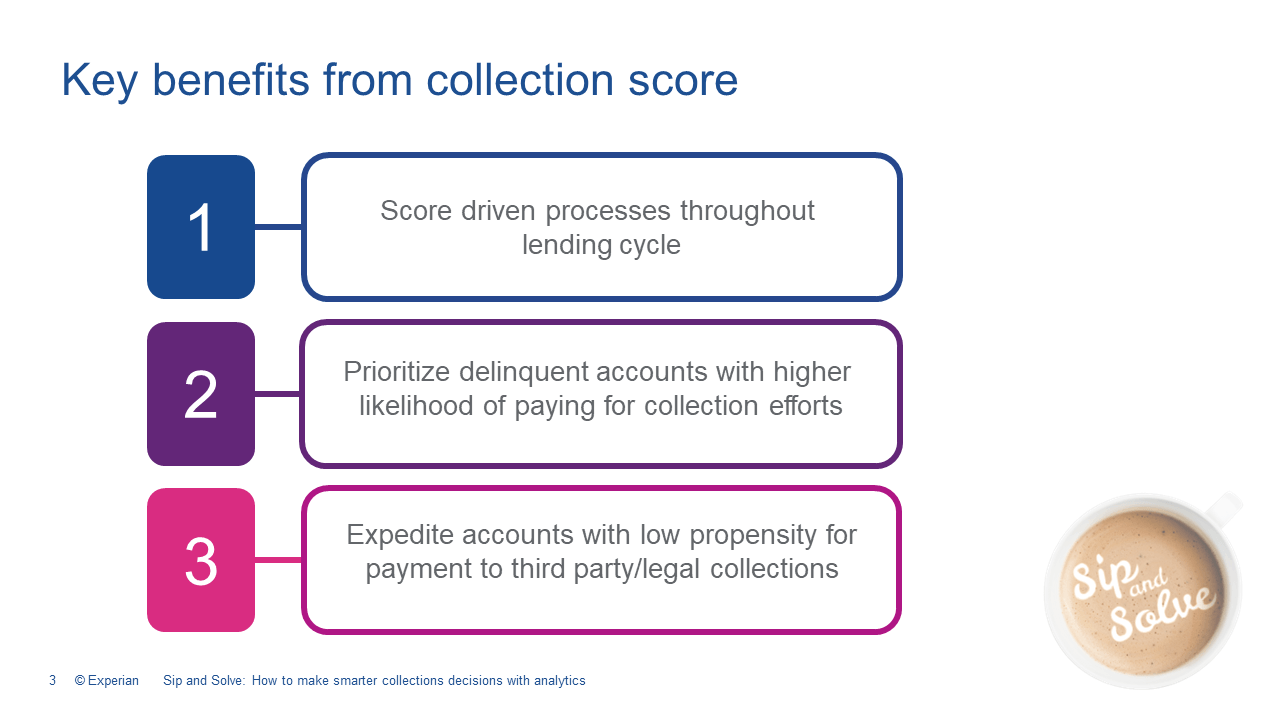
Scores put it in an easily digestible format. a number or dollar amount in the case of a collection score. And in our focus today, the score will determine the odds that you're able to collect what you're owed. You can quantify the value of an account using collection scores and attributes throughout the lending life cycle.
This is really the first key benefit of the score. Using a matrixed approach, and this is what we recommended in the last Sips and Solve to look at a collection score and a portfolio risk score matrix together to identify those accounts that are trending into higher risk segments and utilizing the strategy to identify those businesses that have a lower ability to repay the debt.
In doing that, it could lead you to a consolidation offer. For these clients. Or portfolio management activity. And it's really pre collection, pre delinquency even. So, the second key benefit here of a collection score is that they help you to prioritize which of your customers are more likely to repay.
And this is the point in your collection process where your expectation is to collect just, I mean at this point, pennies on the dollar. You want to know earlier in the process so you can take some additional activities. But you want to know, will my client self-cure? Are they going to pay, are they going to continue to roll into more severe delinquency status?
So that leads to the third key benefit of a collection score. If the account propensity to repay is below the threshold that you set, you're really determining agency allocations at that point by the collectability potential. and the transition of the account to the third-party collection, collector that really fits.
And this is going to help you to reduce some of your back-end costs and really assign the appropriate third party. Now let's look briefly at a few of the other tools that are available to support your collection strategy. Not all of these tools fall squarely in the collection process and that's important to understand.
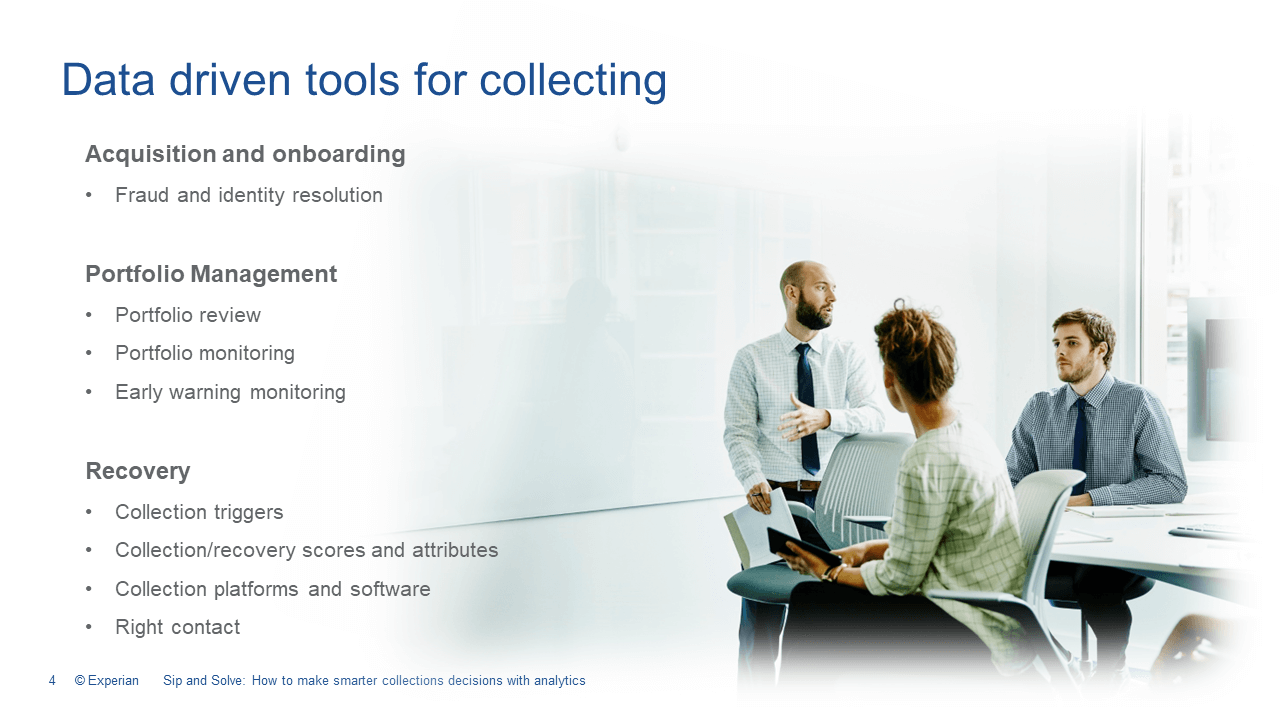
When you think about collections, it should start with customer service and understanding the needs and financial health of your customers. It starts while the customer is still in good health. And I want to say it again, still in good health and not delinquent. Identifying fraud and resolving identity in the acquisitions phase.
Confirming the client is who they say they are up front will help you to reduce the number of never pays or bust out accounts going through your back-end process. When you monitor customer performance through your portfolio management process on and off book, and everything on doesn't equal everything off, um, it, it'll help you to identify trends and early warning signals that would lead to accounts going into arrears.
So, once you're in that recovery mode, so we're in the back end now, Triggers and scores and attributes will help you to prioritize activities required by the urgency their ability to repay. And the exposure that you have for those debts that are associated with the accounts.
Essentially prioritizing the accounts into different segments of recovery risk. Experian offers these building blocks to segmentation as well as platforms and software to take this segmentation analysis and create contact strategies. And that's important for the form of touch that you're addressing the debt and your client.
You're identifying the right contact from the most current contact information. Now let's talk briefly about the process of collections. The typical account receivable process. At an early stage, and the first party is you, you would send an invoice or a reminder letter to your client.
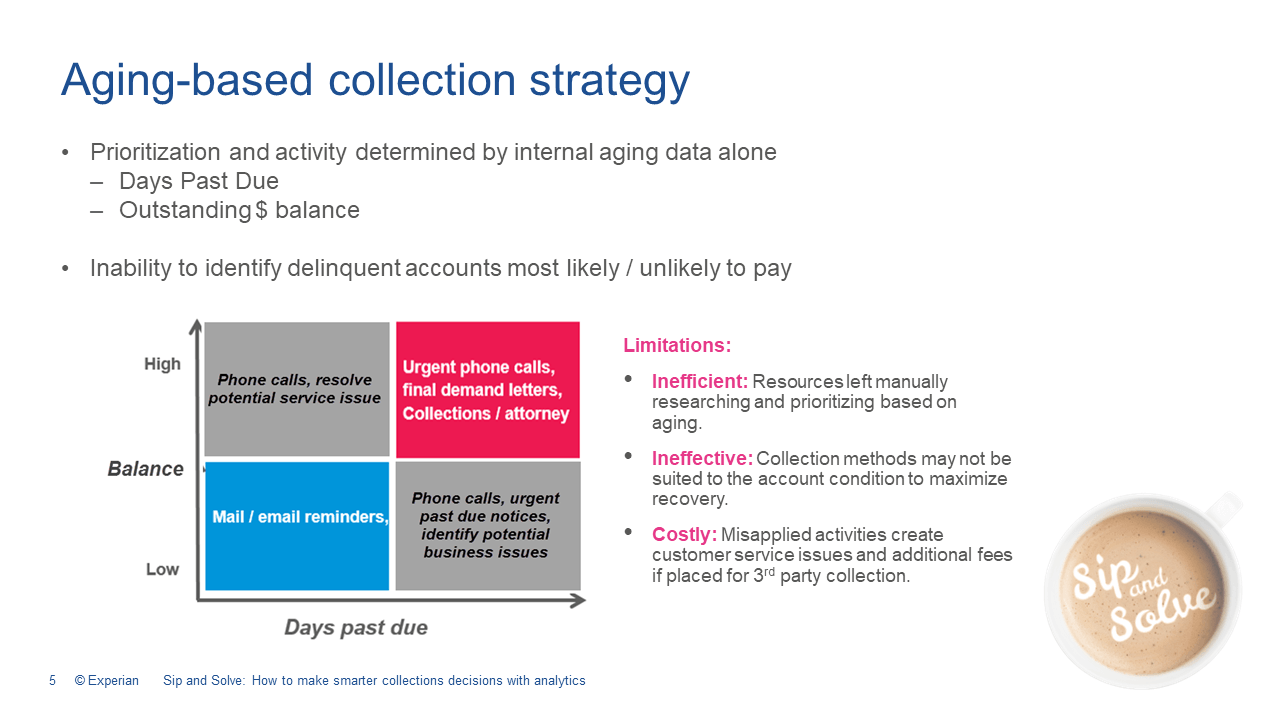
And as that account ages or the delinquency becomes more 30 to 60 days past due, you escalate your efforts with phone calls or a more strongly worded letter surrounding the outstanding amount. Some of you, 30 to 60 days may be too long. You may be doing this within a few days of the delinquency occurring.
So, if it continues to roll into a more delinquent or severe delinquent status it should... potentially go to a more experienced collector and are those folks that you have on staff. You may not have these resources for the later stage. You should prepare for that transition to a third-party collector or to legal.
And those are a little more expensive. These could be accounts that are in arrears, that we see in some of our clients up to 180 days old. So, a collection strategy will help you know when these late-stage collections should be transitioned. Now when we look at a standard process for accounts and arrears and here, we're looking at an age-based strategy, the accounts are prioritized by the highest dollar amount to be collected and days past due.
The highest percentage of accounts spend a lot of time when we look at our clients, they spend a lot of time prioritizing and performing skip tracing activities, just really trying to get the clients in the right order that they're going to contact and ready to be contacted. So how do we move from this standard style or strategy into something that addresses efficiency as well as the client situation and need that you're addressing here with this collection activity?
With the inclusion of a score, and we keep going back to the score because I think it's important, it really helps us to, in the automation process, to make fast decisions. You can prioritize the accounts by the highest dollar, days past due, amount to be collected but you can also look at the collection score.
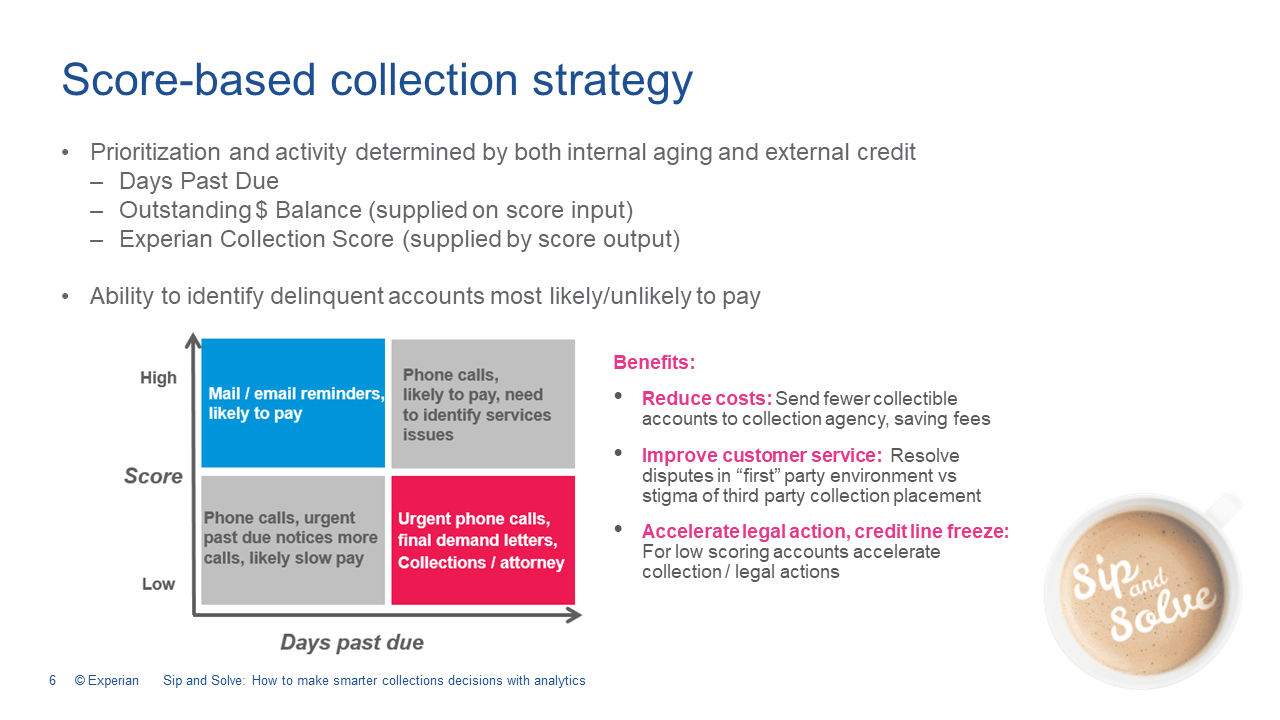
To understand the risk and what's really at risk here that's in arrears. The chart shown that you're seeing here in the bottom left is a fitting example when you're evaluating your good customers and what you're going to see here is that there are diverse ways to address a client depending on where they fall within the chart.
So, you'll see those that are in the top left are good customers. They're easy to pay and true up. They're in the blue box, a light touch. It's easy to bring them back into a loyalty position. The top right gray box could just be a misunderstanding or a billing issue that caused the account to roll into this late stage of delinquency.
So, customer service is going to be more targeted with the first party collector, and that's you. Versus an agency who may not have that same connection with the customer. Not saying that it's a terrible thing, I'm just saying that you might have an opportunity to use the loyalty that they have in this group to really bring back that recovery and up their recovery effort.
You don't want to lose these profitable customers because in the future when they get back on their feet, they're going to come back. So, you can reduce the effort required to transition them to a third-party collection agency if you're addressing it here. Now those in the red box low score, substantial number of days past due, that's going to require quick, high touch, and a more seasoned collector.
To really reach out and address that debt quickly because it is at risk. The first to the table is likely to get a bigger slice of the pie. And so, you always want to get there and make sure that you're the first there ready to take your piece.
Collections really is a fluid customer interaction, full of surprises and colorful people and stories. If you've ever been in a collection agency, you'll hear all the stories. They are really interesting to listen to and interesting in how you're addressing clients need and getting them back to a right position. So, knowing how to efficiently segment and apply the different strategies will make your customer feel that you know their needs and you understand the best way to support them in this time of imbalance.
So, what are some of the challenges that you're going to face as a collector? You're going to be assessing the risk that the customer is not going to pay you back. You're going to be addressing challenges using some of the tools we discussed today through a combination of delinquency, balance, behavior scores, driving that outbound strategy.
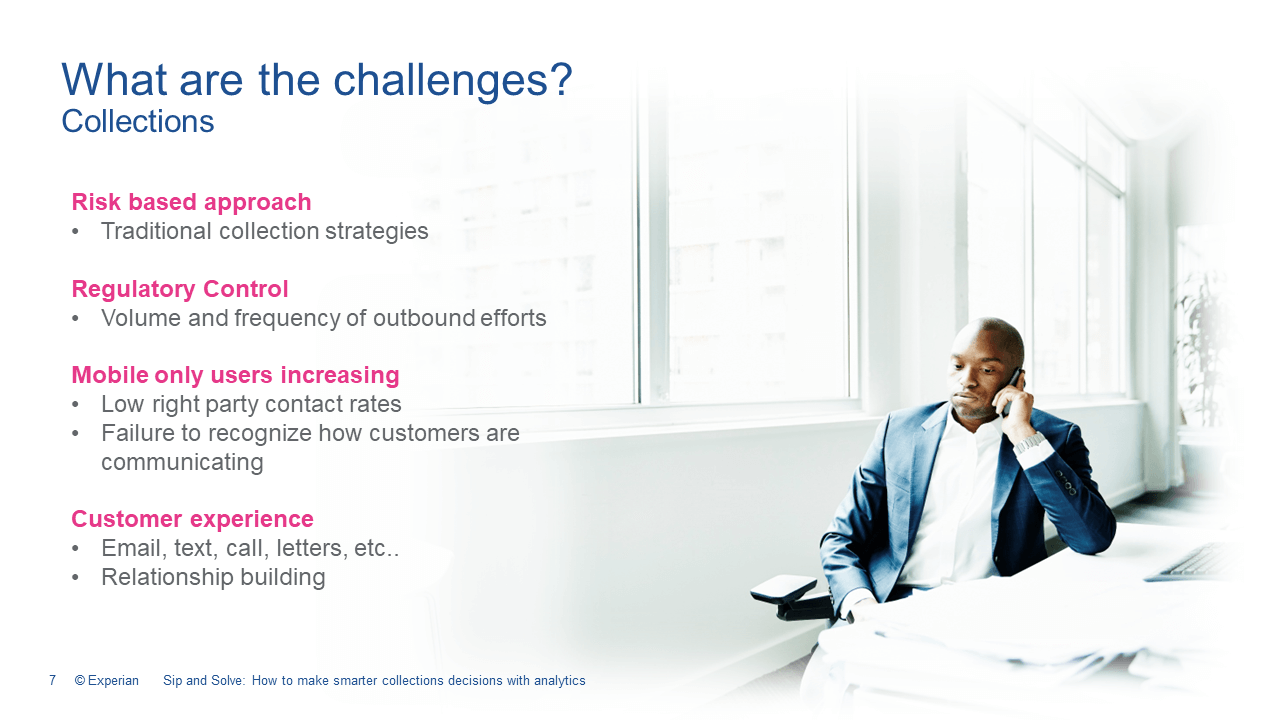
You're going to face regulatory oversight through regs like TCPA that place guardrails around the volume and frequency of your outbound efforts. In our digital environment today, you're going to have increased mobile users. So, it's going to be harder to get that right contact rate right, and those rates have been at record lows.
Customers and mobile phones, if you pull out your mobile phone, it's easy to find an app or a blocker to keep those collection calls out. Just a different environment than we've had in the past. So traditional collection centers really don't recognize how customers are communicating with their company.
Utilizing these preferences accordingly and a digital communication strategy through text calls and emails will really allow the collection center to meet the customer where they want to engage, so it may be different from each client, and really communicate around that debt and try to work out a repayment plan and through different channels.It really adds value and client satisfaction.
So, what should you take away from today's session? Don't look at your collection strategy as a last resort. It should be part of the life cycle of all your accounts, knowing your customers and putting them first. You have many tools here at your disposal.

Attributes, triggers, scores, software, platform, all which Experian offers and can support you with consulting and any type of help you need to set up your strategy - we’re here to help. Collection strategies and challenges continue to evolve, and certainly as a recession is imminent, know that legislation activity will increase.
And putting yourself ahead of the curve, getting your strategy running well now will make a difference and require capital requirements really limiting the origination of a, addressing customer needs faster. So, putting you in a better position to collect a higher percentage of those collectible dollars available.
Get a bigger piece of your pie. So, what I learned from my time with collections team is that doing collections the right way where it's going to bring your customers back when they regain their balance. Knowing that you're going to treat them fairly, meet them where they are, if they get off balance a little bit and one of the things, I learned is that It's not always the case that the most aggressive collectors are the most successful.
It's the smart collectors that are successful.

Brodie Oldham leads a team of statistical consultants while remaining an active strategic statistical consultant for Commercial Data Sciences within Experian. He has 18+ years of experience in disciplines including: analytics; database development; prospecting. In his current role, Brodie provides the marketing and sales organizations with customized analytic support. Prior to joining Experian, he worked at Citi Cards and Citi Mortgage as the Consumer Credit Risk Analytical Consultant.
We will be scheduling more Sip and Solve sessions. Sign up below to be notified.
This site is protected by reCAPTCHA and the Google Privacy Policy and Terms of Service apply.